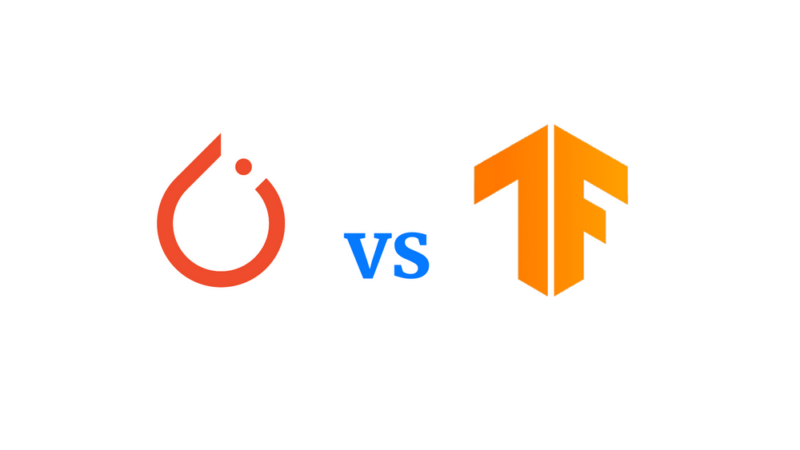Pytorch vs. TensorFlow are both the best deep-learning frameworks. By using these models, we have witnessed many innovative, intelligent systems built on deep-learning models that recognize human emotions, facial behavior, and objects.
But what’s deep learning, anyway? It’s a subset of AI, with complex algorithms derived from the human brain for information processing. In order to learn complex patterns from data, it uses layers of artificial neural networks.
However, these models are complex and require specialized software tools to understand them. Therefore, it is necessary to use frameworks such as PyTorch vs.TensorFlow to simplify this process.
The two most popular Deep Learning Frameworks today are PyTorch and TensorFlow. The debate about which framework is better has been ongoing and heated for decades, with passionate supporters on both sides of the argument.
It is generally easier to learn and use PyTorch, especially for those who have never used it before. It is ideal for research and quick prototyping because of its more dynamic computation graphics. TensorFlow, on the contrary, has a reputation for its scalability and production readiness features that make it an excellent choice to deploy massive installations.
This Blog will discuss which framework to choose, pointing out the differences between Pytorch vs. TensorFlow features and the strengths of both.
Difference Between PyTorch Vs. TensorFlow
The battle between which framework is best Pytorch vs. Tensorflow has been a long-standing debate among machine learning enthusiasts. Both are powerful deep learning frameworks, and understanding the differences between them can help you select the right one for your projects.
| Feature | PyTorch | TensorFlow |
|---|---|---|
| Ease of Use | Easier for Python programmers | Steeper learning curve |
| Flexibility | Highly flexible with dynamic graphs | Less flexible with static graphs |
| GPU Support | Excellent GPU acceleration | Excellent GPU acceleration |
| Scalability | Good, but not necessarily best for massive models | Scales well for large-scale deployments |
| Community | Active community, but smaller than TensorFlow | Larger community with wider industry adoption |
| Development | Open-source, under Linux Foundation | Open-source, developed by Google |
| Applications | Research, rapid prototyping, NLP, CV | Production, large-scale deployments, mobile |
| Ecosystem | A growing ecosystem with useful libraries | A more mature ecosystem with diverse tools |
What is PyTorch:
PyTorch is an open-source machine learning library based on Torch and Python programming languages. It is mainly used for natural language processing and applications such as computer vision.
Unlike other deep learning frameworks, PyTorch is known for its user-friendly Python interface, which makes this library easier for people to understand the concepts of deep learning. It’s also useful for researchers and those who like to experiment as they go so that on-the-fly adjustments can be made while building your model.
Thanks to its extensive support for math operations, it’s a good choice for deep learning research and artificial intelligence applications. Adam Paszke initiated the origin of PyTorch in his internship project with Soumith Chintala, a Torch designer.
Today, PyTorch is widely utilized, including at Meta (formerly Facebook), where Chintala conducts AI research.
-
PyTorch Origins and Evolution
As a successor to the Torch library, PyTorch was initially developed by Meta AIformerly Facebook AI. In doing so, it sought to overcome some of Torch’s limitations while exploiting its core strengths. Open-source principles have been at the heart of its work.
This focus has been reinforced by its governance of the Linux Foundation since 2022 and ensures that it continues to develop as a collaborative, community-driven project.
-
PyTorch Dynamic Computational Graphs
PyTorch stands out for its use of dynamic computational graphs. Unlike some deep learning frameworks that require a pre-defined plan for your neural network, PyTorch lets you build the network structure as you go during training.
It allows you to modify and adjust your project in the development phase. This flexibility will enable you to experiment with different architectures easily, swap out layers, and fine-tune your model.
It’s particularly helpful for debugging since you can directly see how data flows through the network and pinpoint any issues. This dynamic approach makes PyTorch a favorite for rapid prototyping, research, and situations where you’re constantly iterating on your model.
However, it’s important to note that this flexibility can sometimes come at the cost of efficiency compared to static graphs used in large-scale training scenarios.
Benefits of Dynamic Graphs
This dynamic approach offers several advantages.
- Flexibility: You can make decisions and define parts of the model based on the input data. This allows for more intricate and adaptable models.
- Efficiency: PyTorch only builds the graph parts used in a specific run. This can save memory and improve performance for models with variable-length inputs or control flow.
- Rapid Prototyping: Since the graph is built dynamically, you can experiment and modify your model structure more easily during development.
-
Pythonic and Intuitive Interface of PyTorch
One of PyTorch’s biggest strengths is its Pythonic and intuitive interface. For those who are already comfortable with Python, this means that it feels natural and familiar. PyTorch achieves this user-friendliness in the following way.
- Using Native Python Constructs: Python concepts such as loops, conditionals, and arrays of NumPy are used to build PyTorch operations. That’s why it’s easy to understand and write the code for building and manipulating neural networks. You’re not going to need a completely new syntax; this is just an extension of your current Python skills.
- Readability through Eager Execution: PyTorch is using eager execution, unlike some frameworks that have separate learning and inferencing phases. That’s because your code will define the computations according to their execution order. It’s as if you’re writing a step-by-step recipe, and it’s clear and easy to follow. This approach is much easier to use for debugging and understanding model logic.
- Flexibility with Built-in Functions: In order to define common layers and operations of the network, PyTorch provides a very large set of Builtin functions. These functions are the same as any other Python function, making integrating them into your code easy.
- NumPy Integration: You’ll find yourself at home with PyTorch if you know how to use NumPy, the foundation of Python scientific computing. PyTorch’s Tensors are very similar to NumPy’s arrays, and many operations can be performed interchangeably. The learning curve of PyTorch has been reduced by this smooth integration between the two libraries.
Key Features of Pytorch
PyTorch stands out as a versatile and developer-friendly deep learning framework. Here are five core features that make it a favorite among researchers and practitioners.
- Pythonic interface: For those who are already comfortable with Python, this means that it feels natural and familiar. It’s based on well-known concepts such as the numpy tensor and functions that allow you to seamlessly combine your existing Python knowledge with Deep Learning projects. In addition, the code flows are easier to read and understand because they follow an imperative programming style. The model-building process is simplified by encapsulating the complexity of functions through higher abstraction levels for joint deep-learning operations.
- Dynamic Computational Graphs: PyTorch uses dynamic computation graphs, unlike some frameworks that use Static Graphs. In the course of development, this offers considerable flexibility. During training, you can define and change the network structure. Imagine building a model that allows you to experiment with different architectures, add or remove layers, and configure the network according to your needs.
- Tensor Computations with GPU Acceleration: Similar to the NumPy arrays, Tensors lie at the heart of PyTorch. These tensors can exploit the power of GPUs to perform complex computations at high speed. This is essential for training complex deep-learning models requiring extensive numerical computation. To significantly increase your performance, PyTorch will seamlessly integrate with GPUs and allow you to use their parallelism.
- Automatic Differentiation: A fundamental feature of training deep learning models is calculating gradients. Gradients indicate how adjusting the model parameters will affect the final output.PyTorch’s automated differentiation algorithm effectively handles this computation. It will calculate the gradients at every step of a computational graph, enabling you to refine your model’s parameters and enhance its performance.
- Open-Source and Community-Driven: PyTorch’s commitment to open-source principles encourages a collaborative and transparent development process, allowing researchers and developers to be involved in the evolution of this framework. The active PyTorch community provides valuable resources, tutorials, and support, making it easier for beginners to learn and experienced users to stay up-to-date.
What is TensorFlow
TensorFlow is a comprehensive framework that Google created to solve the problems of Deep Learning. It covers all stages of the process, from model development to deployment.
You can use it to design and train complex algorithms that learn from data, like a toolbox with prebuilt components and functions. TensorFlow provides a variety of abstraction levels that allow users to work at multiple levels of complexity, from high-level APIs such as Keras to lower-level functions for refining models.
TensorFlow is famous for its flexibility, which enables it to process large amounts of data and complicated models efficiently. This makes it appropriate for practical applications on the ground. In addition, it offers a wide range of tools and functions for building different types of machine-learning models.
-
TensorFlow Origins and Evolution
The roots of TensorFlow go back to an internal Google project, DistBelief, which was developed around 2011. DistBelief was designed for large-scale machine learning on distributed systems, particularly in terms of speech recognition and language translation,
Recognizing the need for a complete end-to-end production machine learning system, Google introduced TensorFlow Extended (TFX) in 2017.
-
TensorFlow Static Computational Graphs
TensorFlow uses a concept called static computational graphs to represent the flow of data and computations in your machine learning model.
Dynamic computation graphs within TensorFlow provide a structured and effective approach to creating machine learning models. They excel in scenarios where performance, scalability, and deterministic behavior are priorities. Here is a breakdown of static graphs and their advantages.
Benefits of Static Graphs
- Efficiency: Once the graph is defined, TensorFlow can optimize it for performance. This pre-planning can lead to faster execution, especially for repetitive tasks with constant graph structure.
- Scalability: Static graphs are well-suited for deploying models in production environments. The defined graph structure allows for efficient execution on various hardware platforms, including specialized AI accelerators.
- Deterministic Output: A given input will always produce the same output since the graph is fixed. This deterministic behavior is crucial for specific applications where consistent results are essential.
TensorFlow Extended (TFX) for Production Deployment
TensorFlow Extended (TFX) is a powerful open-source toolkit built on top of TensorFlow that streamlines the process of deploying machine learning models into production environments. Here’s how TFX tackles the challenges of production deployment.
- End-to-End Orchestration: TFX is more than just a training model. It lays down a framework for managing the entire machine learning lifecycle, from data validation and preprocessing to model serving and monitoring. Imagine being the conductor of a complex orchestra and ensuring that all components work together smoothly.
- Modular Components: TFX divides the deployment process into different stages, each represented by a modular component. These components may be tailored and combined to form a production pipeline that is suited to your needs, allowing for flexibility and reusability.
- Integration with Existing Tools: TFX integrates well with popular orchestration platforms like Kubeflow Pipelines and Airflow. This allows you to leverage existing infrastructure and tools within your organization’s workflow.
- Automated Monitoring and Alerting: There is a need for constant vigilance in the production models. The TFX service provides monitoring model performance, data drift detection and anomaly alert capabilities. This proactive approach will ensure that your models continue to produce optimal results in the future.
- Focus on Scalability and Performance: TFX is built for production environments. It can handle large datasets and complex models efficiently, ensuring your machine learning pipelines perform well under real-world loads.
Key Features of TensorFlow
TensorFlow is a leading framework for building and deploying machine learning models. Here’s a glimpse into five core features that make it a versatile tool for researchers and practitioners.
-
- Static Computational Graphs: Unlike specific frameworks, TensorFlow adopts static computation graphs, which precisely represent data flow and computations within your model. This methodology presents several advantages, making it a favorable choice.
- Efficiency: The pre-defined graph allows for performance optimizations, leading to faster execution for repetitive tasks.
- Scalability: Static graphs are well-suited for production deployment on various hardware platforms, including specialized AI accelerators.
- Deterministic Output: The fixed graph structure ensures that a given input always produces the same output, which is crucial for applications requiring consistent results.
- Eager Execution (Optional): TensorFlow introduces a highly efficient execution mode that contrasts with the conventional static graph approach. This innovation enables a more Pythonic coding style, where computations occur after defining them. Such flexibility proves invaluable for swift prototyping and debugging tasks.
- TensorFlow Extended (TFX): This additional library extends TensorFlow’s functionalities, specifically targeting production deployment needs. TFX (TensorFlow Extended) furnishes a comprehensive framework for overseeing the complete machine learning lifecycle. It encompasses tasks ranging from data validation and preprocessing to model serving and monitoring, ensuring a streamlined and efficient process from development to deployment.
-
Vibrant Community and Resources: TensorFlow boasts a large and active community that contributes to its development and offers extensive resources. This includes comprehensive documentation, tutorials, code examples, and forums where users can get help and share knowledge.
- Flexibility and Multi-Platform Support: TensorFlow supports various programming languages (Python, Java, C++) and can run on different platforms, such as CPUs, GPUs, and TPUs (Tensor Processing Units). This flexibility allows you to choose the environment best suits your needs and computational resources.
- Static Computational Graphs: Unlike specific frameworks, TensorFlow adopts static computation graphs, which precisely represent data flow and computations within your model. This methodology presents several advantages, making it a favorable choice.
PyTorch vs. TensorFlow Use Cases
To grasp the concept of both frameworks, we need to distinctly understand Pytorch vs. Tensorflow deep learning frameworks; both are powerhouses, but each shines in specific scenarios. Here’s a breakdown of their strengths to help you choose which is best suited for your project.
PyTorch Usecase
PyTorch is a popular choice for various deep-learning applications due to its flexibility. These are two compelling examples of its strengths in the real world.
-
-
- Drug Discovery with Deep Generative Models
- The Challenge: It takes a lot of time and money to develop new medicines. Traditionally, in order to identify potential drug candidates, researchers rely on laborious experimentation.
- The PyTorch Solution: In order to create powerful generative models, researchers use PyTorch’dynamic computational graph. These models can learn from existing data on molecules and generate new virtual molecules with desired properties, which could accelerate the discovery of drugs.
- User Experience with Recommender Systems
- The Challenge: Recommendation systems play an important role in the different online platforms, recommending products, movies, and music that may interest consumers. However, creating effective recommender systems requires processing large amounts of user data and accounting for dynamic user preferences.
- The PyTorch Solution: PyTorch’s flexibility is well-suited for building recommender systems. To generate personalized recommendations, developers can use PyTorch to create deep-learning models that analyze user behavior, item attributes, and contextual information.
- Drug Discovery with Deep Generative Models
-
These models can be constantly updated with new data to ensure that the recommendations continue to be useful and user-friendly.
TensorFlow Usecase
TensorFlow, focusing on scalability and production readiness, is a dominant force in deploying deep learning models for real-world applications. Here are two areas where TensorFlow shines.
-
-
- Improving Image Recognition for Self-Driving Cars
- The Challenge: Self-driving cars rely heavily on robust image recognition systems to navigate roads safely. These systems must accurately identify objects, pedestrians, and traffic signals in real time under various lighting and weather conditions.
- The TensorFlow Solution: TensorFlow’s ability to run big datasets and complex models makes it an excellent tool for Deep Learning Model Training in Self Driving Vehicles. Engineers can use TensorFlow to build convolutional neural networks, CNNs, which can effectively recognize objects in images captured by car cameras. TensorFlow’s production-ready features, such as Extended TensorFlowTFX, are designed to allow these models to be efficiently deployed and continuously monitored for optimal performance in real-world driving scenarios.
- Anomaly Detection in Financial Transactions
- The Challenge: Financial institutions constantly battle fraudulent activities like credit card fraud or money laundering. The current methods of detecting anomalies may not be sufficient to cope with the evolution of fraud systems.
- The TensorFlow Solution: TensorFlow is able to handle massive amounts of finance transaction data thanks to its high scalability. In order to analyze transaction patterns and identify anomalies that could indicate fraud, data scientists can build deep learning models with TensorFlow. Over time, these models will learn and adapt, improving their ability to detect new fraud tactics.
- Improving Image Recognition for Self-Driving Cars
-
Making the Right Choice for Your Project – Pytorch vs. Tensorflow
Choosing between PyTorch and TensorFlow can be tough, as both are excellent deep-learning frameworks. Here’s a breakdown to help you make the right decision for your project:
-
Strengths of PyTorch
- User-friendliness: PyTorch shines with its Pythonic interface, making it easier for those familiar with Python to learn and use.
- Flexibility: Dynamic computational graphs allow you to experiment with different network architectures during training, ideal for rapid prototyping and research.
- GPU Acceleration: Seamless integration with GPUs for efficient tensor computations, leading to faster training and inference.
-
Strengths of TensorFlow
- Scalability and Production: TensorFlow excels in large-scale deployments and production environments, offering robust tools for distributed training.
- Large Community and Industry Adoption: A more comprehensive industry adoption rate and a larger community can provide more resources and support.
- Mature Ecosystem: TensorFlow boasts a mature ecosystem of libraries and tools for various deep-learning tasks. (TensorFlow Lite for mobile deployment is a notable example)
Choosing the Right Tool
- PyTorch might be a better choice for rapid prototyping, research, or projects requiring flexibility.
- TensorFlow could be preferable for large-scale deployments, production environments, or projects requiring extensive community support.
Remember, both PyTorch vs. TensorFlow are powerful tools. The best choice ultimately depends on your specific project requirements and team preferences.

Dawood is a digital marketing pro and AI/ML enthusiast. His blogs on Folio3 AI are a blend of marketing and tech brilliance. Dawood’s knack for making AI engaging for users sets his content apart, offering a unique and insightful take on the dynamic intersection of marketing and cutting-edge technology.










